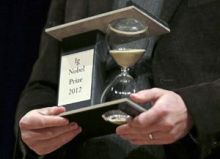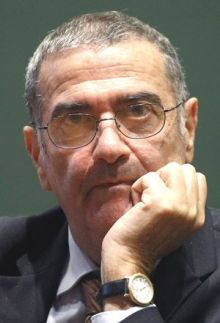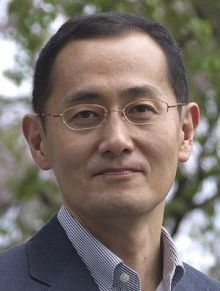The Swedish Academy of Sciences presents winners of the 2012 Nobel Prize for physics and medicine. On October 9, 2012 Professor Staffan Normark, Permanent Secretary of the Royal Swedish Academy of Sciences, read the Nobel Committee’s brief official decision in two languages, Swedish and English. The 2012 Nobel Prize in Physics was awarded jointly to Serge Haroche (France) and David J. Wineland (USA) “for ground-breaking experimental methods that enable measuring and manipulation of individual quantum systems.”
Serge Haroche was born in 1944 in Casablanca, Morocco, which then was under the French protectorate. His mother, nee Rubliova, was born in Odesa. Haroche is professor and chair of quantum physics at the College de France (Paris, France), member of the French, European, and American Physical Societies. In 2009, he was awarded a gold medal by the French National Centre for Scientific Research.
David J. Wineland was born in 1944, Milwaukee, WI, USA, and is currently working for the National Institute of Standards and Technology in Boulder, CO, USA. He is a member of the American Physical and Optical Societies. He was the first to demonstrate the laser ion cooling technology in 1978. In 2004, Wineland led a team of researchers in the first ever demonstration of quantum teleportation of information among massive particles.
It is common knowledge that light consists of particles called photons. They are moving coherently, without pauses, at the speed of light. It has been physicists’ longtime ambition to “catch” and even isolate the photon from other particles. The problem is that the connection between these super-mobile particles and the rest of matter could not be captured by direct experiment, the main difficulty being the dramatic difference between the quantum world of particles and the macro-world we are used to. A quantum particle combines both coherent (wave) and discrete (discontinuous) properties. The difference can be easily demonstrated on the example of ripples on the water, if you drop a rock in water. Our eye can only see the continuous rings on water, although water is made up by molecules which, in their turn, are built of atoms. The latter are also made up by elementary particles with spaces in between, albeit very little. The ripples look continuous, yet at the same time their movement is discrete. Of course, this example is illustrative and does not necessarily reflect the complexity of the microworld.
The main object describing the behavior of the microworld particles is the wave function, whose modulus squared represents a probability or probability density of that very particle at a certain point in space. Interestingly, the wave function can assume not only actual, but also complex values, i.e., it can be expressed via the so-called imaginary unit, square root of negative one. For example, the electron clouds of an atom (a notion from the high school chemistry and physics curricula) are nothing other but three-dimensional distribution of the wave function square, the equivalent of the electron.
The behavior of elementary particles is not described in determined categories. We can only say with a definite probability that at a given moment, the particle has such-and-such a coordinate in space. It is quite probable; but with a different probability, it is not there at all.
Let us imagine now that we have to observe such mobile particles with a most complex behavior with the help of the same particles. For example, that we have to observe photons with the help of photons. In other words, any measurement makes an inevitable impact on the system. Due to this, the system loses all of its quantum properties and becomes a classic system.
Until recently physicists believed that this obstacle was of fundamental character. It was formulated by the authors of quantum mechanics, the outstanding Danish physicist Niels Bohr and the German physicist Werner Heisenberg in the 1920s, as the so-called Copenhagen interpretation.
To graphically illustrate the postulates of the Copenhagen interpretation, the famous Austrian physicist Erwin Schrodinger came up with his equally famous cat. Imagine a black box with a cat inside. Besides the animal, the box also contains a flask of poison and a single radioactive atom, which can trigger a mechanism breaking the flask. If the radioactive atom decays, an internal monitor detects radioactivity, and the flask is shattered, releasing the poison that kills the cat. Conversely, if the atom does not decay, the cat lives. For an outside observer, after the time of the radioactive element’s physical half-life is over, the cat in the box is simultaneously alive and dead. Moreover, the probability of the cat’s being alive or dead is equal, 1 to 2. Being outside the box, there is no way we can clearly determine if the cat is alive or dead at any moment.
The progress of physics has proved the narrow-mindedness of this interpretation. It is this year’s Nobel winners who made the breakthrough.
In the 1980s quantum optics – a section of quantum mechanics – was going through a period of rapid upsurge. This was due to, among the rest, technology which had reached the level, necessary for the manufacturing of the relevant equipment. The so-called cavity resonators became a popular object for study. They actually consisted of a couple of reflecting mirror elements with an electromagnetic field induced between them. Physicists have succeeded in enabling the emerging photons to live long enough before being absorbed by the walls of the box.
Some scientists used such cavities to make masers – microwave lasers, i.e., sources of coherent (harmonized) emission in the microwave range, while others studied the interaction of photons and atoms of matter. Haroche wondered if there was at least one photon inside a resonator.
The answer was supposed to be found without destroying the photon in the resonator, i.e., without causing its wave function to collapse.
The task turned out to be doable. Specially selected original states of atoms changed in a particular way while the atoms passed through the resonator. The state of an atom can be represented as a wave, and if there was a photon, the extremes of the wave were shifted. This could be recorded by conventional measurements. By using more than one atom, Haroche created the technology to count up the number of photons in the resonator.
American scientist David Wineland approached the problem from the other side. He studied the behavior of ions placed in a sort of “trap,” a vacuum chamber with static and oscillating electric fields. These fields allow holding and examining single ions. For the development of such a trap, known as Paul ion trap, the 1989 Nobel Prize in physics was awarded to Wolfgang Paul and Hans Dehmelt.
Wineland’s chief achievement was a smart use of laser pulses. It turned out that applied in a special way, they can “push” an ion down to the ground state level. Then, by applying other pulses, the ion can be transferred into a superposition of the ground and the following excited energy levels. Having received the ion in a truly quantum state, scientists were at last able to study these mysterious objects.
Besides their fundamental importance, the Nobel winners’ experiments will have an extensive application in future. In particular, mankind is standing on the verge of creating the quantum computer with computational potential that is orders of magnitude – by 10 to the power 80 – beyond current supercomputers. The creation of such computers would change our lives in this century as much as the creation of their predecessors did in the previous.
It is the huge amount of calculations that makes precise long-term weather forecasting impossible. The success of developing cures for cancer, AIDS, and other lethal diseases is also curbed by the insufficient productivity of today’s computers.
Another task, which quantum devices will be able to solve, is a more precise time measurement. Optical clocks will be at least 100 times more precise than today’s cesium clocks. An error of 1 second will occur after 3.7 billion years. As a result, we can have a much more perfect system of monitoring objects and calculating their coordinates in space. The next step is autonomous driving systems for automobiles, which will allow to prevent road accidents. At the moment, we can only guess how the computer revolution can affect the progress of microbiology and medicine, as it will fundamentally expand the possibilities of studying life on the genetic level.
This year’s Nobel Prize in physiology or medicine was awarded jointly to Sir John B. Gurdon and Shinya Yamanaka “for the discovery that mature cells can be reprogrammed to become pluripotent.” In other words, for producing induced stem cells.
Sir John B. Gurdon is a British biologist, renowned for his work in cell nuclei transplantation. He was born in 1933 and got his degree from Oxford University in 1960. He did his postdoctoral work at the California Institute of Technology. In 1962 Gurdon did an experiment where he replaced the nucleus of a frog egg cell with the nucleus of an intestine cell. Such egg cells later developed into normal tadpoles. The experiment proved that the genome of highly specialized cells preserves sufficient information to ensure work of all cells of a system, while their specialization is reversible.
Shinya Yamanaka was born in Osaka, Japan in 1962 – the year when Gurdon’s landmark paper was published. He graduated from the Kobe University and obtained his doctoral degree at the Osaka University in 1993. The research which brought Yamanaka the Nobel Prize was done 40 years after Gurdon’s experiments. In 2006, Yamanaka co-authored a paper which expounded how, by activating only four genes in conjunctive tissue cells, the latter can be transformed into stem cells and afterwards give rise to any cells.
All metazoans develop from a single cell called a zygote, i.e., an impregnated egg cell. As soon as the zygote starts to divide and form new cells, they start to acquire certain specialization: some become neurons, while others make up adipose tissue, for instance. A special line of cells with time gives rise to new egg cells. Cell differentiation is sometimes compared to falling off a mountain. It is easy to slide into a certain “specialized valley,” but it is impossible to come back to the summit.
Although each cell in the system (with a few rare exceptions) has a genome identical to that of the zygote, its further fate is determined by the specialization this cell acquired. Normally, a fully ripe cell cannot change its specialization, or even divide.
Adult organisms have cells with a weak specialization, which give rise to several types of mature cells. Such weakly specialized cells divide and make up for the organism’s losses. In the broad sense, they are termed stem cells, or more precisely, multipotent cells. It is multipotent cells that produce new blood cells, new epithelium cells (whose replacement is critical for the organism’s existence), and regenerate damaged tissues.
For humans, the irreversibility of cell specialization means that an adult organism’s potential for tissue regeneration is very limited. Having lost a considerable proportion of stem cells, the system stops regenerating with time, and the process of irreversible aging is triggered. It is known that brain stem cells disappear almost completely as early as at the intrauterine stage, and they are not subsequently restored. They remain dormant and can be triggered, for instance, in case of a stroke. However, adult neurogenesis uses the limited, irreplaceable store of these cells, and at a certain point it is exhausted.
Cell reprogramming and creating new stem cells are critical for the further progress of biology and medicine. For this, Gurdon removed the nuclei of cells with the help of ultraviolet radiation and then injected nuclei from tadpole epithelium into the prepared cells. The resulting cell gave rise to a normal frog. Later this technology was used for cloning sheep, mice, swine, dogs, and other animals, including the famous Dolly sheep.
Yamanaka held a number of very intricate experiments in cell reprogramming, which not only developed Gurdon’s ideas, but also introduced new elements. Production of infinite numbers of induced stem cells can potentially provide humans with the tools for triggering regeneration processes, and thus enabling longevity. This technology has most obvious applications in the treatment of Parkinson’s disease, as well as cancer, cardiovascular conditions, and diabetes. Scientists now have a wonderful technology for the study of cell differentiation mechanisms, which has a brilliant future ahead.
The outrageous neglect and responsibility of Ukraine’s government towards the promotion and development of science has wiped all hope to see the names of our scientists on the list of Nobel Prize aspirants, despite Ukraine still having potential for advancing to the front line of science. Sadly, it looks as if the government had very little interest in the problems of science – maybe, resulting from a bad lack of gray matter?












